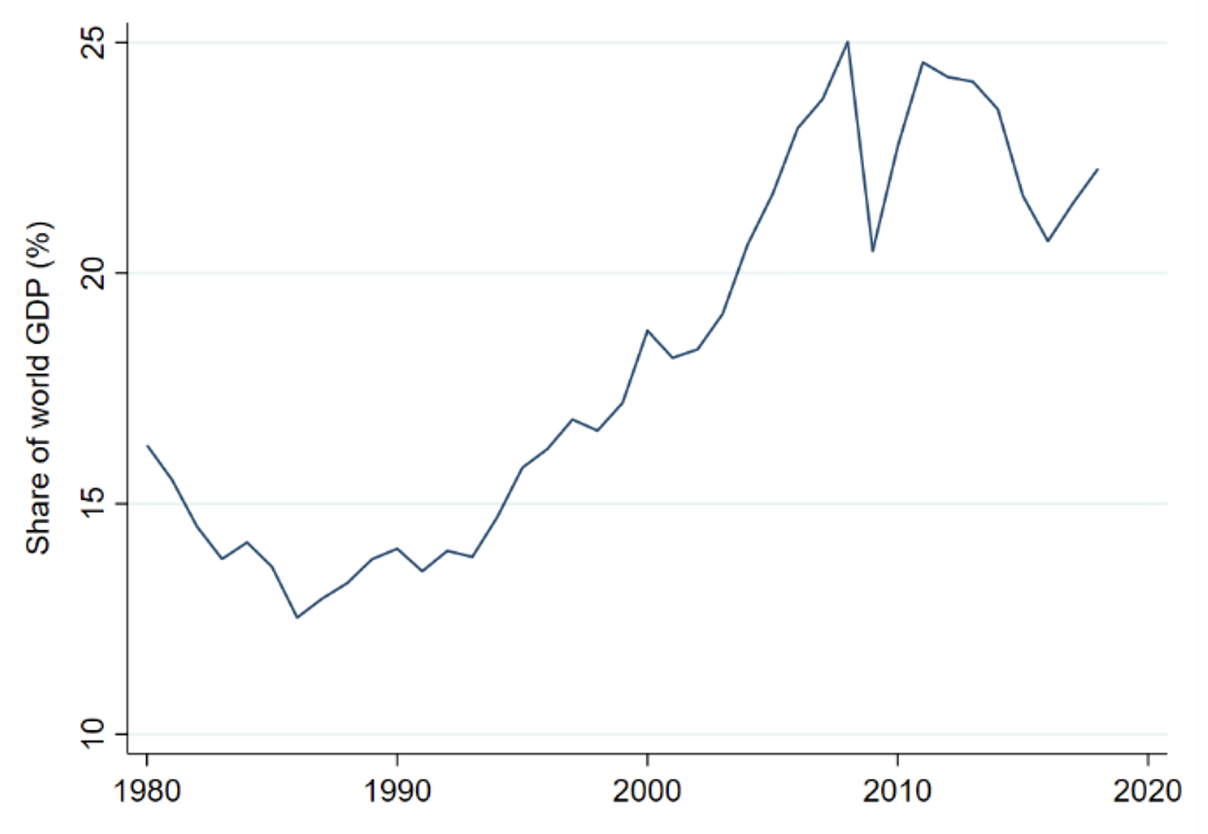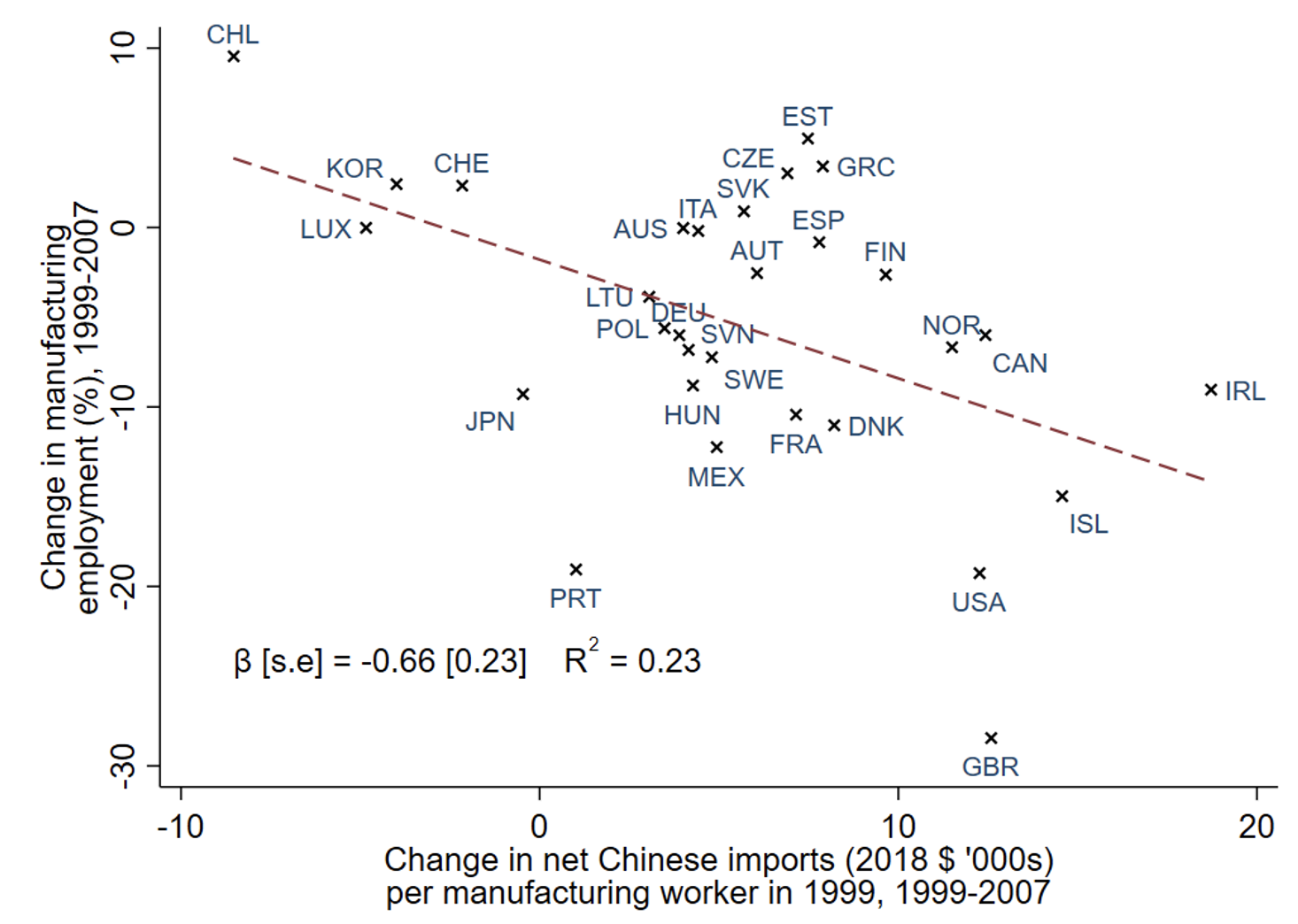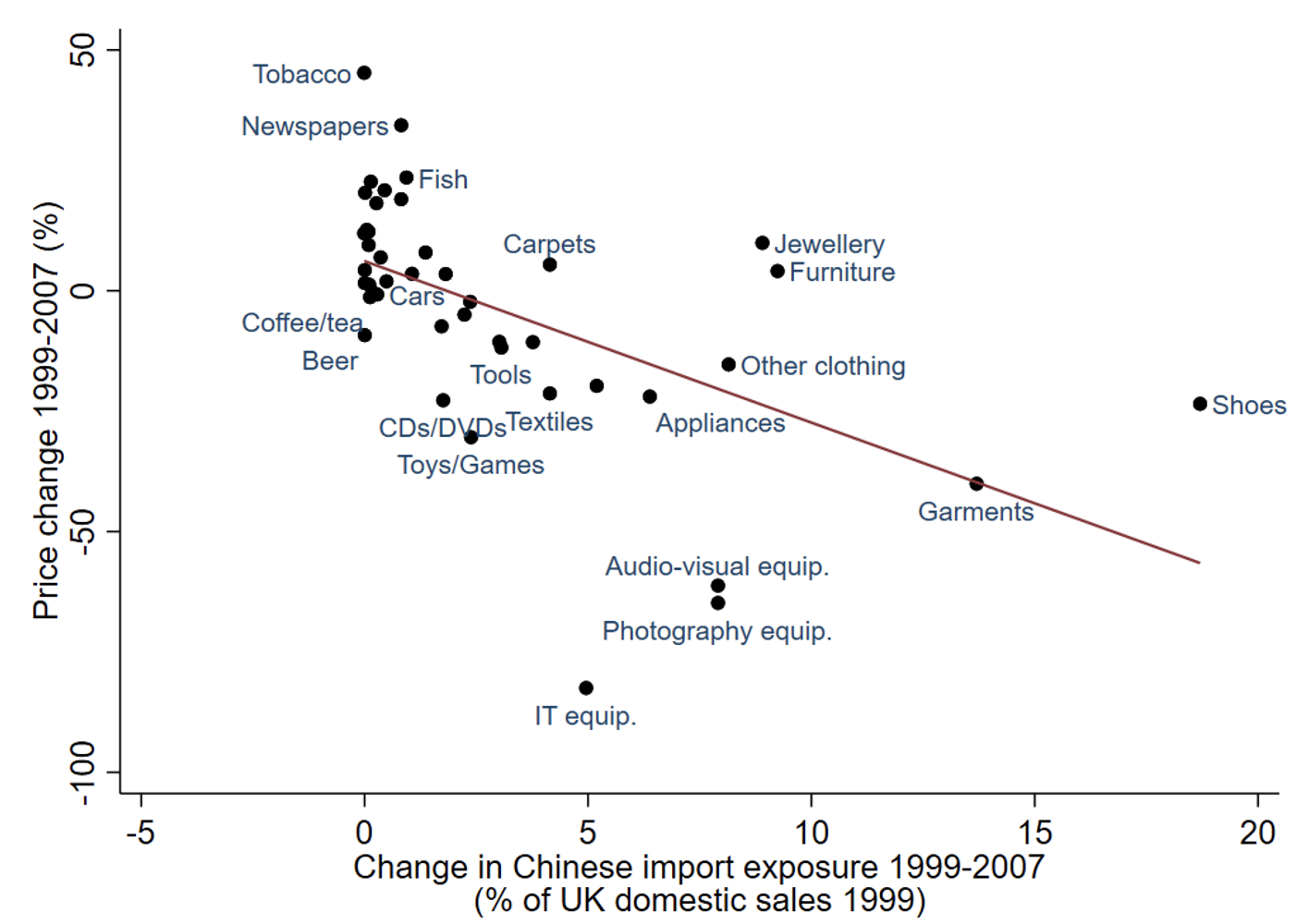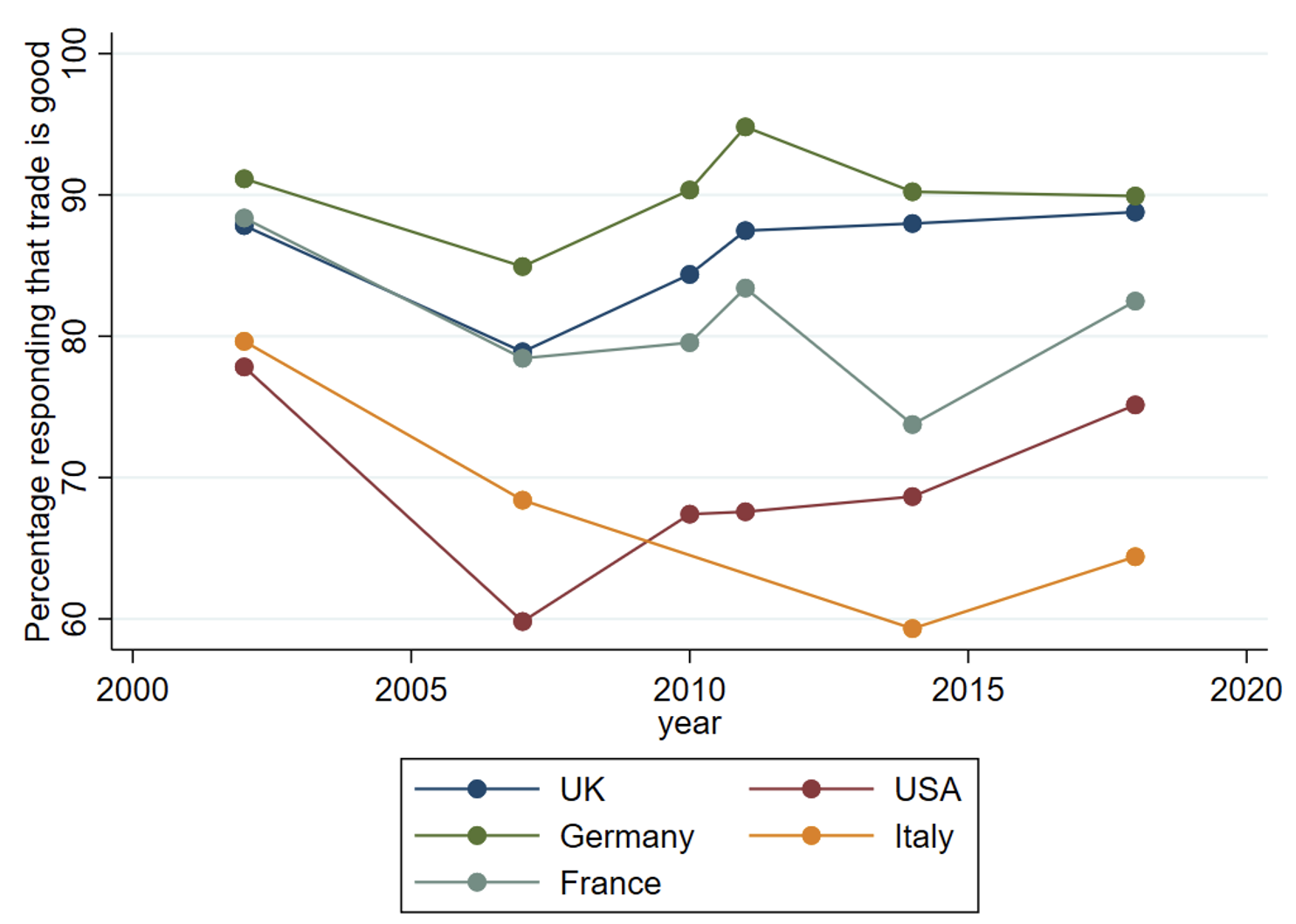Jump directly to
Trade’s impact on inequality
The consensus view until the 2010s was that trade had little impact on inequality in high-income countries. This column reviews the recent evidence that challenges this view. Manufacturing employment contracted sharply in countries like the US and the UK which faced rapid net import growth from China. The resulting, persistent adverse effects on employment and incomes of low-skilled workers do not appear to have been offset by trade’s effect on prices, which seems to have benefited rich and poor households alike. Mitigating these effects is an important but difficult task for policymakers.
This column by David Dorn and Peter Lewell (Institute for Fiscal Studies) was originally published on «VoxEU.org», 14 February 2022. Edited for layout purposes by the UBS Center.
The notion that ‘trade can make everyone better off’ is a fundamental tenet of economics; Gregory Mankiw’s (1997) popular introductory textbook presents it as one of the ten principles of the discipline. However, a positive effect of trade on aggregate welfare does not preclude the possibility that trade produces losers. Indeed, basic models of international trade long suggested that globalisation could increase the wage gap between high- and low-skilled workers in wealthy economies.
The 1990s and 2000s saw a step-change in the pace of globalisation, providing an opportunity to put theoretical predictions relating trade and inequality to the test. During these two decades, the ratio of global merchandise trade to world GDP nearly doubled (Figure 1), with a growing share of goods originating from low-income countries. The transition of communist countries towards a market-oriented economic system with greater trade integration was an important factor contributing to this trade boom. China, now the leading exporter of manufactured goods, was the largest contributor to the growth of world trade during the 1990s and 2000s. Trade integration was further catalysed by rapid improvements in communication technology, the spread of regional trade agreements, declines in tariff rates, and lower transportation costs.
In most empirical studies performed during this period, trade was not found to be an important driver of growing wage inequality in the US or Western Europe. The eventual Nobel Laureate Paul Krugman noted in 1995 that “a preponderance of research to date suggest that the impact of third world exports on first world labour markets has been small” (Krugman 1995). Even 13 years later, towards the end of the wave of globalisation, there remained a “consensus that trade has only modest effects on inequality” (Krugman 2008).
However, as the growth in imports levelled off in the 2010s, research started to show that trade had a more disruptive impact on labour markets than had been previously thought. For example, the rapid growth in Chinese manufacturing imports in the 1990s and 2000s reduced the career earnings of US and UK workers who were initially employed in import-competing industries, compared to similar workers in less-exposed industries (Autor et al. 2014, Utar 2018, De Lyon and Pessoa 2020). These adverse labour market outcomes were most pronounced among low-wage workers. Moreover, the geographic areas where import-competing firms clustered experienced not only declines in earnings and employment levels (e.g. Autor et al. 2013, Dauth et al. 2014, Malgouyres 2017), but also changes in social outcomes and attitudes. Studies have also linked greater local exposure to import competition to a deterioration in the local provision of public goods (Feler and Senses 2017), adverse health outcomes and greater mortality (e.g. Pierce and Schott 2020, Adda and Fawaz 2021), a dissolution of traditional family structures (Autor et al. 2019), and greater support for extreme political parties and politicians, especially on the far right (e.g. Colantone and Stanig 2017, Autor et al. 2020, Dippel et al. 2022).
These findings have led to a reappraisal of economists’ views of the impacts of trade on inequality in rich countries (Wood 2018). In 2021, Paul Krugman noted that “economists, myself included, have tended to underplay the disruptive effects of rapid change. … Many of us feel that we missed something important about the downsides of globalisation” (Krugman 2021). What had the classical approach to understanding trade’s impacts missed? Textbook models of trade assume that workers smoothly transition from declining industries and regions to growing ones. A trade shock to specific industries would then rapidly dissipate in the broader labour market, affecting workers only through modest changes in national wage levels. In reality, there are frictions. Workers exposed to adverse shocks take a long time to find new work, or to move to new locations. As a consequence, the labour market effects of trade shocks are heavily concentrated on specific groups of workers that were initially employed in a set of exposed industries, and the geographic localities where such industries cluster. Trade shocks can thus create considerable inequality across groups of workers and local labour markets, and these inequalities appear surprisingly persistent over time (Autor et al. 2021).
In a recent chapter prepared for the IFS Deaton Review on Inequalities (Dorn and Levell 2021), we contrast the labour market experiences of high-income countries during the recent wave of globalisation. Many countries faced a similarly rapid increase in import competition from China. However, a few countries such as Germany and Switzerland were able to also expand exports substantially to China. This partly reflected the specialisation of these countries in manufacturing sectors that saw rapid increases in Chinese import demand. Evidence from German local labour markets indicates that manufacturing employment expanded in regions whose industries found new export opportunities in China and Eastern Europe, offsetting employment losses in other local labour markets whose industries faced growing import competition (Dauth et al. 2014).
Following this logic, it is possible that rapidly rising trade between high-income countries and China during the 2000s led to larger declines in manufacturing employment in countries where import growth from China strongly exceeded export growth, and more modest employment changes in countries whose trade with China remained balanced. We find support for this hypothesis in Figure 2, which indicates that manufacturing employment contracted particularly rapidly in countries such as the US and the UK, which saw strong net Chinese import growth (measuring the difference in imports and exports) during the 1999–2007 period, while remaining more stable in countries like Germany or Switzerland, which experienced more limited net import growth.
Trade can impact inequality not only through its uneven effects in the labour market, but also through changes in consumer prices. We investigate such effects using price and expenditure data from the UK. Figure 3 shows that goods categories that saw the most rapid increases in Chinese imports, such as apparel and home electronics, also experienced particularly large price declines. Who benefited most from these price changes? We find that in the UK, low-income consumers devote a modestly larger share of their total expenditure to goods relative to high-income consumers, but goods consumed by the rich experienced somewhat larger price declines. Overall, we estimate that imports reduced the prices faced by rich and poor households by approximately the same proportion, a result consistent with recent evidence from the US (Borusyak and Jaravel 2018). Thus, these price reductions do not appear to have mitigated the other impacts of import competition on inequality.
The experience of the recent globalisation wave contains important lessons for the future. It has become clear that sudden shifts in trade patterns can have damaging and persistent impacts on certain workers and geographic regions. Potentially exposed workers and local areas should ideally be identified before large changes in trade patterns, giving policymakers, businesses, and workers time to prepare for changing economic circumstances. Both active labour market policies to support workers and ‘place-based’ policies to support distressed regions can help to smooth this adjustment, but such policies may also create important trade-offs between equality and efficiency.
In principle, protective trade policies can avert or mitigate trade shocks but they should only be used as a last resort. Such policies prevent consumers and businesses from reaping the benefits of reduced prices, while creating labour market disruptions of their own for workers in industries that purchase their inputs from abroad. Moreover, they can provoke retaliatory measures from other countries. The short-term impacts of the 2018–2019 US–China ‘trade war’ provide an important cautionary tale. Early evidence suggests that new US tariffs on goods imports from China did not substantially raise employment in protected US manufacturing industries (Flaaen and Pierce 2020), but instead led to higher prices faced by US firms and consumers (e.g. Amiti et al. 2019, Fajgelbaum et al. 2020).
There is thus a real risk that ill-conceived protectionist trade measures reduce overall welfare, while bringing little relief to the workers and localities which have suffered from globalisation. However, a backlash against international trade is not inevitable. Public attitudes towards trade remain remarkably favourable in major Western economies (Davenport et al. 2020, Colantone et al. 2021). Figure 4 shows that, while the share of survey respondents reporting that trade is good for their country declined during the climax of the globalisation wave of the 2000s, positive attitudes have rebounded since, with nearly 90% of the public in the UK and Germany and three-quarters of Americans reporting a favourable view on trade.
The consensus view until the 2010s was that trade had little impact on inequality in high-income countries. This column reviews the recent evidence that challenges this view. Manufacturing employment contracted sharply in countries like the US and the UK which faced rapid net import growth from China. The resulting, persistent adverse effects on employment and incomes of low-skilled workers do not appear to have been offset by trade’s effect on prices, which seems to have benefited rich and poor households alike. Mitigating these effects is an important but difficult task for policymakers.
This column by David Dorn and Peter Lewell (Institute for Fiscal Studies) was originally published on «VoxEU.org», 14 February 2022. Edited for layout purposes by the UBS Center.
The notion that ‘trade can make everyone better off’ is a fundamental tenet of economics; Gregory Mankiw’s (1997) popular introductory textbook presents it as one of the ten principles of the discipline. However, a positive effect of trade on aggregate welfare does not preclude the possibility that trade produces losers. Indeed, basic models of international trade long suggested that globalisation could increase the wage gap between high- and low-skilled workers in wealthy economies.





Contact
David Dorn is the UBS Foundation Professor of Globalization and Labor Markets at the University of Zurich and the director of the university-wide interdisciplinary research priority program “Equality of Opportunity.” He was previously a tenured associate professor at CEMFI in Madrid, a visiting professor at the University of California in Berkeley, and a visiting professor at Harvard University.
Professor Dorn’s research spans the fields of labor economics, international trade, economic geography, macroeconomics, and political economy. He published influential studies on the impacts of globalization and technological innovation on labor markets and society.
David Dorn is among the 100 most highly cited economists worldwide in the last decade. In 2023, he was awarded the Hermann Heinrich Gossen Prize for the most accomplished economist in German-speaking countries under the age of 45.
David Dorn is the UBS Foundation Professor of Globalization and Labor Markets at the University of Zurich and the director of the university-wide interdisciplinary research priority program “Equality of Opportunity.” He was previously a tenured associate professor at CEMFI in Madrid, a visiting professor at the University of California in Berkeley, and a visiting professor at Harvard University.
Professor Dorn’s research spans the fields of labor economics, international trade, economic geography, macroeconomics, and political economy. He published influential studies on the impacts of globalization and technological innovation on labor markets and society.
David Dorn is among the 100 most highly cited economists worldwide in the last decade. In 2023, he was awarded the Hermann Heinrich Gossen Prize for the most accomplished economist in German-speaking countries under the age of 45.